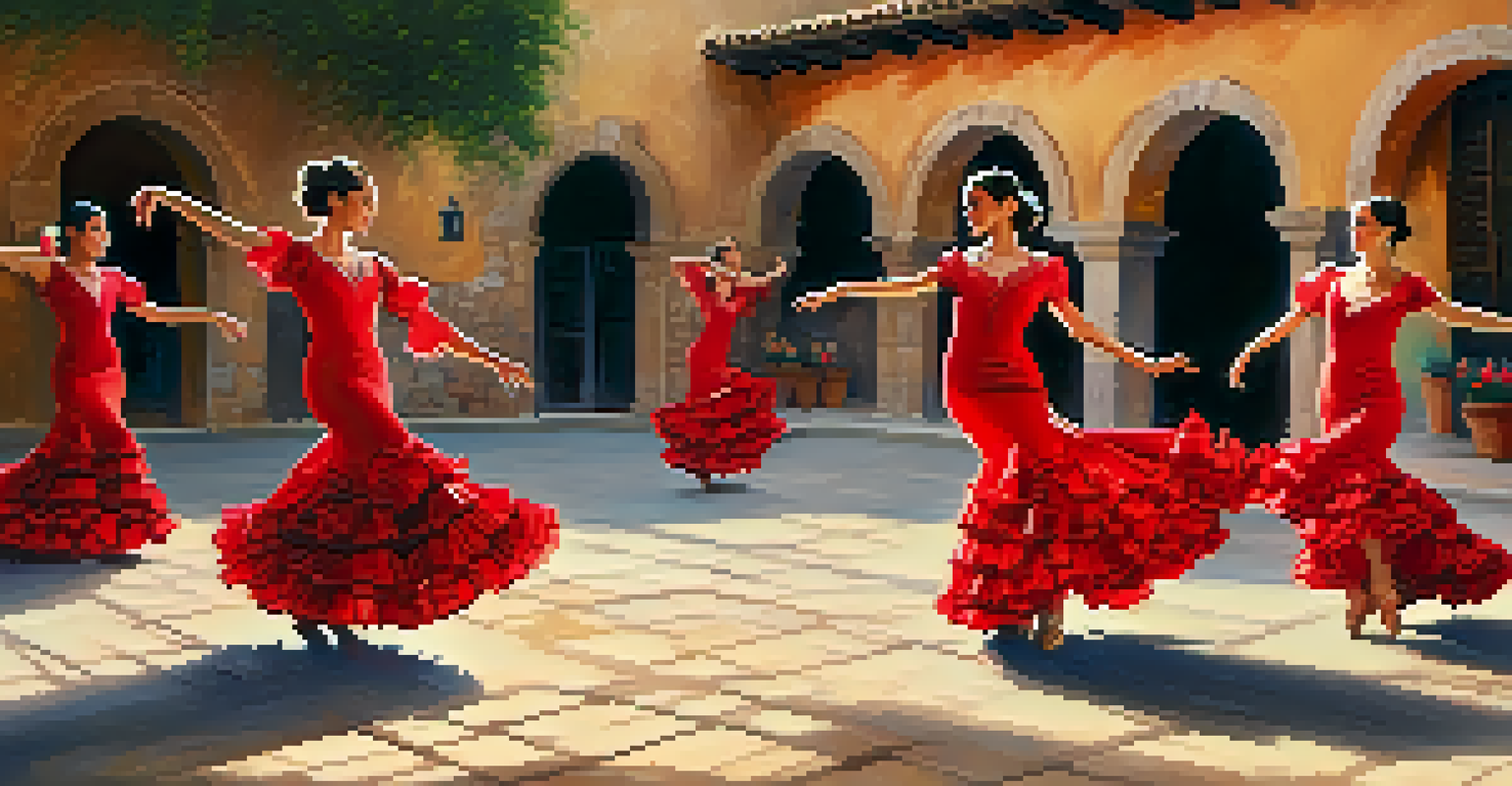Cultural Dance and Its Impact on Social Change Globally

Understanding Cultural Dance as a Global Phenomenon
Cultural dance embodies the traditions and values of a community, serving as a vivid expression of identity. From the spirited movements of the Hula in Hawaii to the intricate footwork of Flamenco in Spain, these dances tell stories that resonate with cultural heritage. They not only entertain but also invoke feelings of pride and continuity within communities, making them a vital aspect of cultural preservation.
Dance is the hidden language of the soul.
Beyond mere performance, cultural dance acts as a means of communication, transcending language barriers. It conveys emotions, histories, and social norms that might otherwise remain unexpressed. This rich tapestry of movement and rhythm invites audiences to engage with different cultures, fostering empathy and understanding.
Moreover, the global exchange of dance styles has led to a melting pot of influences, creating new forms that reflect contemporary social issues. As cultures interact and blend, dance becomes a dynamic medium that can address pressing matters such as inequality, environmental concerns, and identity politics.
Cultural Dance as a Medium for Social Change
Dance has long served as a powerful tool for social activism, often bringing attention to critical issues. In many communities, traditional dances have been adapted to voice concerns about social justice, gender equality, and human rights. For example, the 'Dances of Resistance' movement in various Indigenous cultures utilizes dance to protest against colonialism and advocate for land rights.

This transformative power of dance is evident in the way it can mobilize communities and inspire collective action. Events like flash mobs or dance challenges on social media have sparked widespread movements, showcasing how rhythmic expression can galvanize people around a cause. These vibrant displays not only raise awareness but also foster solidarity among participants and viewers alike.
Dance as a Cultural Identity Tool
Cultural dance helps preserve unique identities and traditions, connecting future generations to their heritage.
Furthermore, dance can serve as a therapeutic outlet for marginalized groups, providing a space for healing and empowerment. Through workshops and community gatherings, individuals can explore their identities and share their narratives, creating a sense of belonging and purpose.
The Role of Dance in Cultural Identity Preservation
In an increasingly globalized world, cultural dance plays a crucial role in preserving unique identities. Many communities utilize dance as a way to pass down traditions, ensuring that future generations remain connected to their roots. Festivals and cultural events often showcase these dances, celebrating heritage and instilling pride among participants.
The dance is a poem of which each movement is a word.
For instance, the revival of traditional Maori Haka in New Zealand has become a symbol of cultural resilience and pride. It serves not only as a performance but as a reminder of the importance of cultural heritage in the face of modernization. This preservation of dance fosters a deeper understanding of cultural narratives, enriching the global tapestry of human expression.
Moreover, cultural dance can challenge stereotypes and misconceptions about certain communities. By showcasing authentic practices, these dances promote appreciation and respect for diverse cultures, countering the homogenization that often accompanies globalization.
Global Examples of Dance Driving Social Change
Around the world, various forms of dance have sparked significant social movements. The 'Ballet for Life' initiative, founded by renowned dancers, uses ballet to advocate for social causes, proving that even classical forms can be vehicles for change. Through performances and outreach, they address issues like health, poverty, and education.
In South Africa, the dance genre known as 'Gqom' has emerged from the townships as a form of resistance and empowerment. It not only entertains but also reflects the struggles of the youth, capturing their aspirations and frustrations in a rapidly changing society. This dance form has gained international recognition, demonstrating the global impact of local movements.
Dance Drives Social Activism
Through performances and community engagement, cultural dance serves as a powerful medium for raising awareness about social issues.
Similarly, the 'Dancing for Change' movement in Brazil combines traditional Afro-Brazilian dance with activism, advocating for racial equality and social justice. This initiative highlights how dance can be a unifying force, rallying communities around a shared vision of a better future.
The Impact of Technology on Cultural Dance and Social Change
Technology has revolutionized the way cultural dance is shared and experienced. Social media platforms allow dancers to showcase their art to a global audience, bringing attention to social issues in real-time. Viral dance challenges can effectively raise awareness and create a sense of urgency around important topics, drawing in participants from diverse backgrounds.
Moreover, digital platforms have facilitated cross-cultural exchanges, allowing for the fusion of dance styles and ideas. This interconnectedness can amplify social messages, enabling them to reach wider audiences. For example, the integration of hip-hop and traditional dances has led to powerful performances that address themes of racial justice and inequality.
However, this digital age also presents challenges, as cultural appropriation can occur when elements of a culture are taken without understanding or respect. It's crucial for dancers and audiences alike to engage thoughtfully, appreciating the context and significance behind the movements they share.
Challenges Faced by Cultural Dance in Promoting Social Change
Despite its potential, cultural dance often faces obstacles in its pursuit of social change. Misrepresentation and commercialization can dilute the original intent behind traditional dances, leading to a loss of cultural significance. When dance is stripped of its historical context, it can perpetuate stereotypes rather than challenge them.
Additionally, funding and support for cultural dance initiatives can be scarce. Many grassroots organizations struggle to secure resources, limiting their ability to reach broader audiences. This lack of support can hinder the transformative power of dance, reducing its effectiveness as a tool for social change.
Technology's Role in Dance Evolution
Digital platforms facilitate the global sharing of dance, fostering cross-cultural exchanges and amplifying social messages.
Furthermore, dancers from marginalized communities may encounter barriers in gaining recognition for their work. It's essential for the global community to uplift and amplify these voices, ensuring that cultural dance remains a powerful force for advocacy and change.
The Future of Cultural Dance and Social Change
Looking ahead, the future of cultural dance as a catalyst for social change appears promising. As awareness grows around social issues, more dancers are using their art to advocate for various causes, creating a vibrant tapestry of movements. This evolution highlights the adaptability of dance, as it continues to resonate with contemporary audiences while remaining rooted in tradition.
Collaborations between artists and activists are becoming increasingly common, resulting in performances that not only entertain but also educate. By merging the worlds of art and activism, these initiatives challenge viewers to engage with social issues on a deeper level, fostering a sense of responsibility and action.

As we continue to navigate an ever-changing global landscape, cultural dance will likely remain a crucial medium for expression and change. By celebrating diversity and embracing the richness of cultural heritage, dance can unite people in their shared aspirations for a better future.